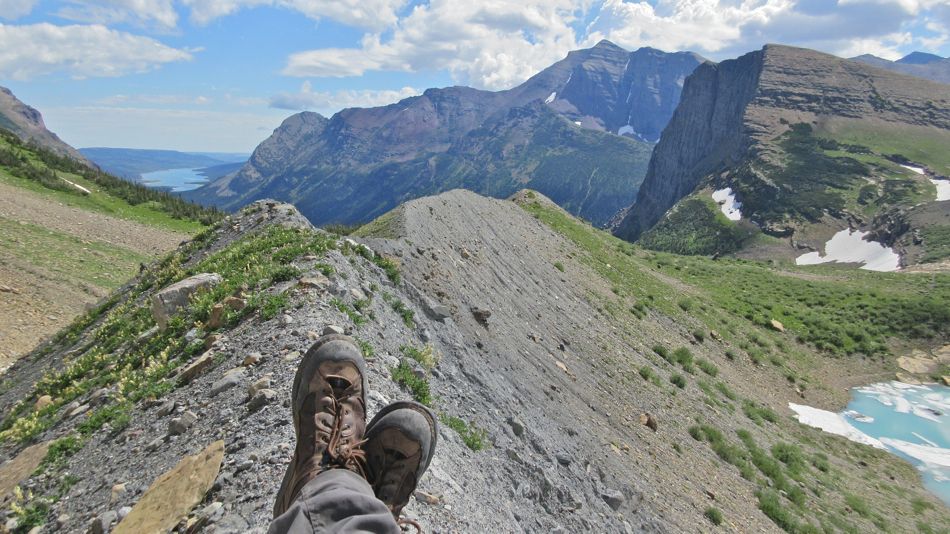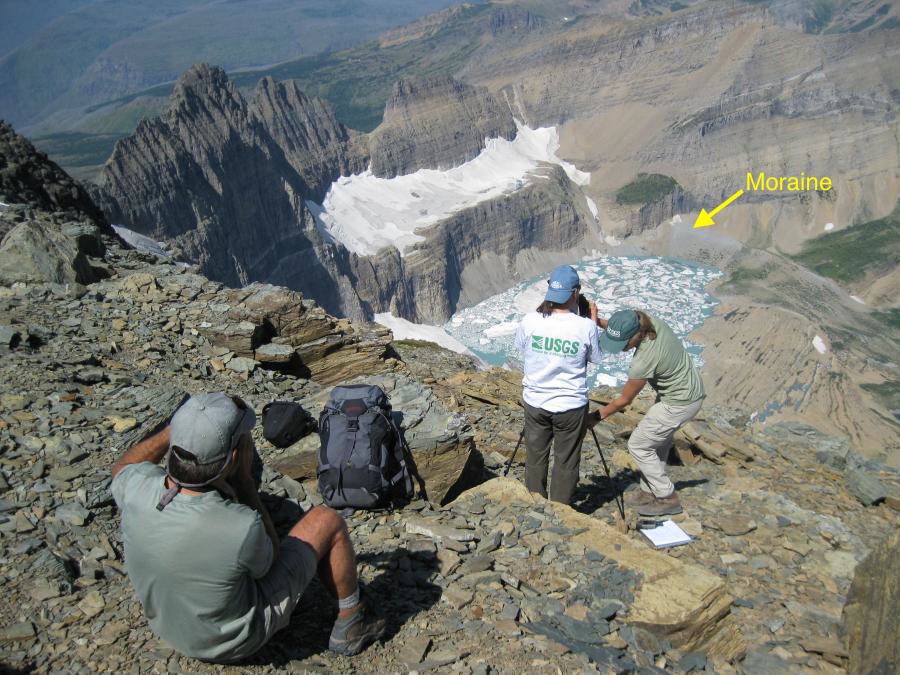|
This is as far as we go. 
Moraine of the Grinnell Glacier
Grinnell Glacier Moraine . . .
This photo, taken near Grinnell Glacier shows a ridge of rock material (till) known as an "end moraine". The moraine consists of rocks of various sizes (unsorted), ranging from silt to boulders - an obvious sign that they were deposited by a glacier. Rocks that were stuck to the bottom of the Grinnell Glacier (or had fallen onto it, etc.) were carried here by the glacier and then dropped as the ice melted at the terminus of the glacier. A significant moraine such as this indicates that the climate must have been stable for several decades, causing the terminus of the glacier to be stationary. If it had been advancing due to a cooling climate, or receding due to warming, the rock material would not have built up as it did here. The span of stable climate that allowed this moraine to form happened during the Little Ice Age, a cold period that lasted for centuries, ending in the mid-1800s. Since then the Grinnell Glacier has been receding due to the warming climate, causing the glacier to melt away from its moraine.
Watch these animations to see how glaciers respond to changes in climate. Be sure to watch all three animations - The first one illustrates how an end moraine forms.
Not the first time the glaciers have melted away . . .
Contrary to popular belief, the glaciers in Glacier Park are NOT "leftovers" from the last ice age, which ended roughly 10,000 years ago. There is little doubt that ice age glaciers WERE responsible for carving the majestic peaks and valleys of the park (horns, cirques, aretes, hanging valleys, etc.), however experts believe those glaciers completely melted away during a warm period 9,000 to 5,000 years ago (known as the altithermal or Holocene Climate Maximum). On the other hand, glaciers present in the park today formed during the Little Ice Age (not a true "ice age") - a centuries long cold period that ended about 150 years ago. According to evidence from moraines, tree rings, layers of volcanic ash, and radiometric dating, these "Little Ice Age" glaciers formed in cirques that were carved by glaciers during the last real ice age(s). The photo at the top of this page shows the end moraine that marks the farthest advance of the Grinnell Glacier during the Little Ice Age (another photo). The photo at below shows that same moraine as viewed from Mt. Gould.
What if he had gone along? . . .
Grinnell Glacier is named after George Bird Grinnell (1849-1938), an American anthropologist, historian, naturalist, and writer. Grinnell was born in New York, and graduated from Yale University with a B.A. in 1870 and a Ph.D. in 1880. As a graduate student, he accompanied Lieutenant Colonel George Armstrong Custer's 1874 Black Hills expedition as a naturalist. Fortunately he passed on a similar opportunity to accompany Custer on the 1876 expedition - All the participants on that trip died at the Battle of the Little Big Horn in June of 1876. Instead, Grinnell lived a long and influential life, which included playing a major role in establishing Glacier Park. After exploring the area in 1885, he was instrumental in getting it designated as a national park in 1910. Who knows? If Grinnell had gone with Custer, the area may have never become a national park.
 Above: Lisa McKeon and Lindsey Bengtson photograph Grinnell Glacier from the summit of Mount Gould in August of 2009. CLICK HERE to see their photo. Courtesy of the USGS
Term: glacial till
|



